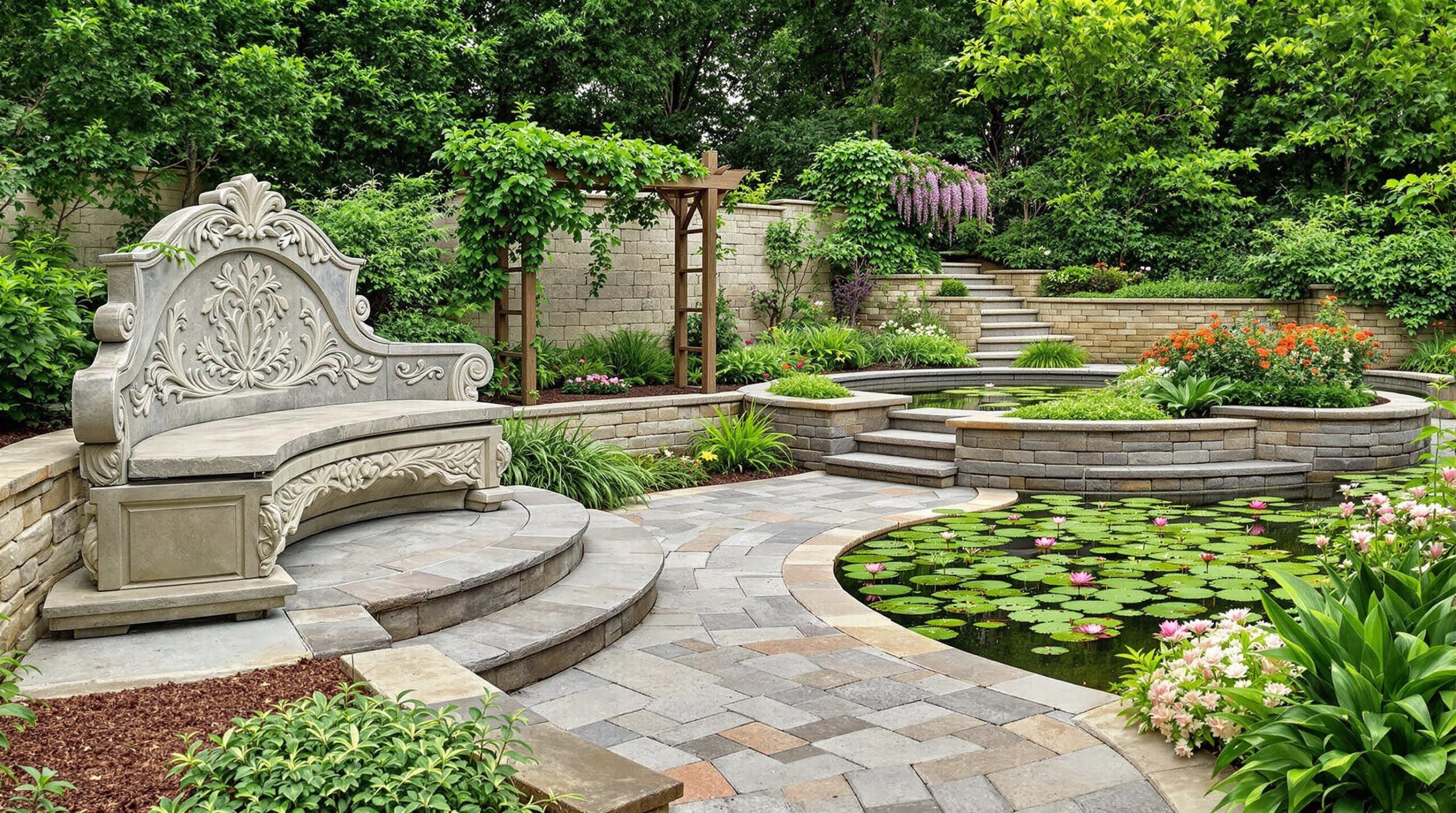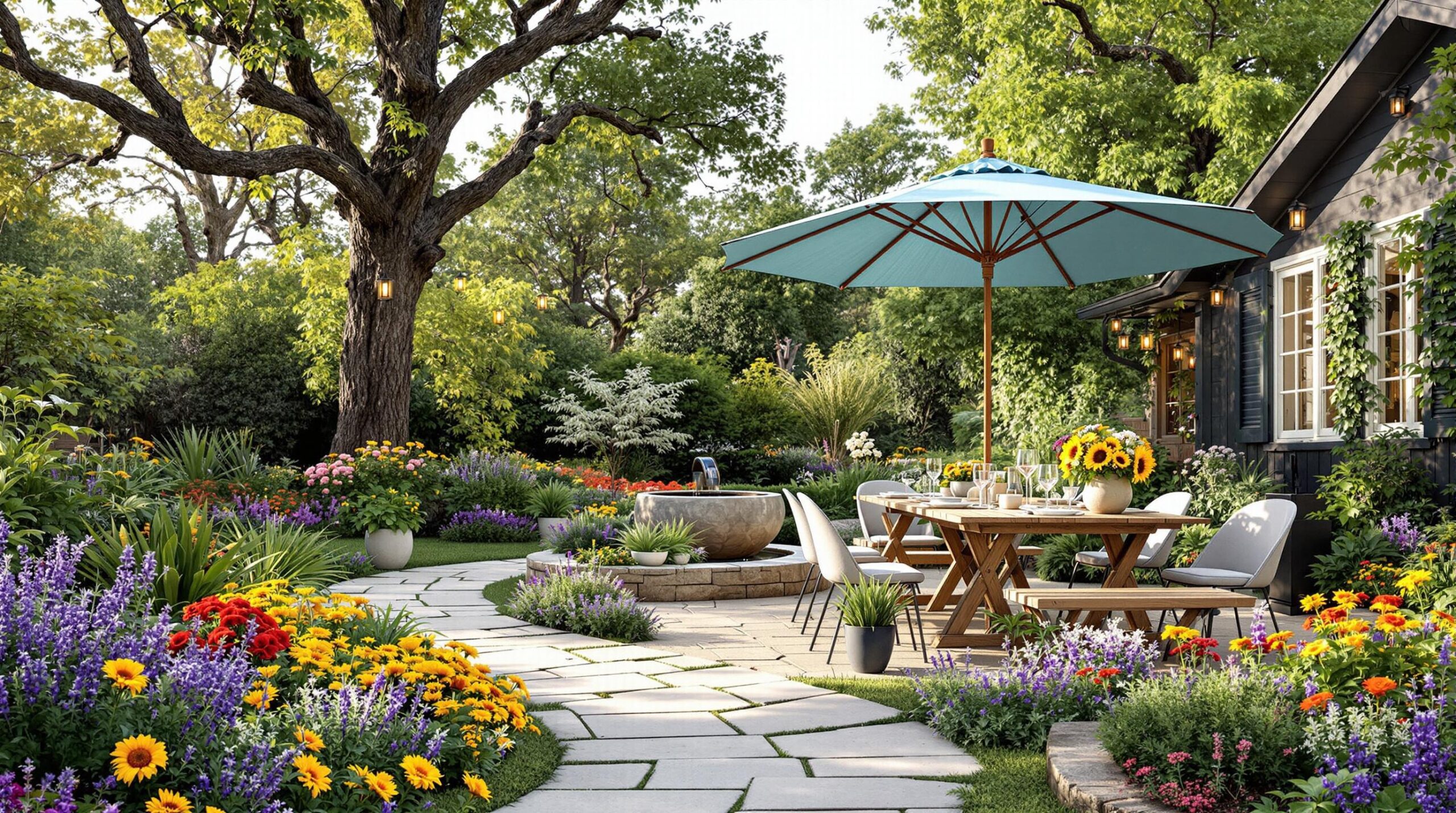Transforming your garden into a captivating outdoor living area doesn’t need to be expensive or professionally executed. By investing some time and creativity into DIY projects like garden pathways and patios, you can significantly boost your home’s curb appeal while crafting functional spaces for relaxation and entertainment. This article will guide you through the design and construction of versatile hardscaping features, ranging from simple gravel paths to more intricate flagstone patios.
Here’s a sneak peek at what we’ll cover:
- The fundamentals of hardscaping
- Must-have tools and materials
- Steps to planning your outdoor features
- Budget-friendly pathway ideas
- Innovative designs for patios
- Incorporating decorative elements and lighting
- Maintenance tips for lasting beauty
- Enhancing your patio with built-in features
- Eco-friendly options for sustainable paths
Understanding the Basics of Outdoor Hardscaping
Outdoor hardscaping encompasses the non-vegetative elements of your landscape design, such as pathways, patios, and other structural features. These aspects provide not just aesthetic value but also contribute to the functionality of your outdoor spaces. When planning your project, it’s vital to contemplate factors like water drainage and the durability of materials, ensuring that your new landscape features integrate harmoniously with your existing elements. A well-thought-out hardscape can enhance your property’s value and your enjoyment of outdoor living.

Essential Tools for Your Hardscaping Project
Gathering the right tools is crucial for achieving professional results. Here’s a list of must-have tools:
- Level: to ensure even surfaces 📏
- Rubber mallet: for setting pavers or stones 🔨
- Shovel and spade: for excavation 🏗️
- Tamper: to compact your soil and base materials 🏋️♂️
- Wheelbarrow: for transporting materials 🚧
Planning Your DIY Pathway and Patio
Before laying down any materials, take time to assess your space and design your layout. This step helps avoid costly mistakes and aligns your project with your needs and preferences.
Assessing Your Space
Evaluate your outdoor area by considering:
- How existing landscaping will incorporate your new features 🌳
- Natural drainage patterns to prevent standing water 💧
- Sun exposure and shaded areas for plant placement ☀️
- Traffic patterns: how people will navigate through the space 🚶
Designing Your Layout
Once you’ve assessed your space, create a detailed plan. Techniques can include:
- Using graph paper or digital tools to sketch your ideas 📐
- Paying attention to the shapes and sizes of your hardscaping features 📏
- Identifying focal points or unique features for incorporation 🌟
Budget-Friendly Pathway Ideas
Creating engaging pathways doesn’t have to be costly. Here are some affordable yet charming options:
Gravel Paths
Gravel pathways are both economical and simple to install, making them a popular choice. They offer excellent drainage and can be adjusted to suit various designs.
- Mark out the desired shape of your path.
- Excavate the area to a depth of approximately 4 inches.
- Lay landscape fabric to prevent weed growth.
- Fill the path with gravel, compacting it as you go.
Stepping Stone Walkways
For a whimsical touch, consider stepping stone walkways! They allow grass to thrive between stones, making them blend beautifully with the garden.
- Select your stones, varying in shape and size.
- Arrange them with proper spacing.
- Excavate for each stone to create a level base.
- Set stones in place, using sand or gravel for stabilization.
Creating Stunning Stone Patios
A DIY stone patio can serve as a beautiful focal point in your outdoor living space. While constructing a patio may require more effort than paths, the payoff is significant.
Preparing Your Ground
Before laying stones, ensure a proper base by following these steps:
- Outline your patio area.
- Excavate to a depth of about 6 inches, accounting for stone thickness.
- Lay landscape fabric for weed prevention.
- Spread and compact a layer of gravel for drainage.
- Add a layer of sand and level it carefully.
Laying the Stone
Once the base is ready, it’s time to lay the stones:
- Begin from one corner and work outward.
- Use a rubber mallet to secure each stone.
- Regularly check for level, adjusting with sand as necessary.
- Fill the gaps between stones with sand or gravel.
Innovative Paver Designs for Pathways and Patios
Explore creative ways to elevate your outdoor pathways using different materials. For example, concrete pavers come in a variety of designs suitable for contemporary outdoor spaces💡. Mix and match sizes and colors for stunning visuals. Permeable pavers are an eco-friendly option, allowing water to drain and reduce runoff.
Incorporating Decorative Elements
Enhance the visual appeal of your hardscape with elements that add character. Consider:
- Mosaic designs for artistic touches 🎨
- Outdoor lighting to improve visibility and ambiance 🌕
- Water features for calming sounds and movement 💧
Maintenance Tips for Lasting Pathways and Patios
To preserve the beauty and functionality of your outdoor spaces, adhere to these maintenance tips:
- Address weed growth promptly 🌱
- Regularly refill joints between materials as necessary 🛠️
- Sweep or blow dust and debris from surfaces frequently 🧹
- Seal natural stone surfaces every few years to guard against stains 💧
PlantSnap: Identifying Plants to Elevate Your Garden Design
Enhancing Your Patio with Fire Pits and Built-In Features
Adding a fire pit or built-in barbecue can convert your patio into an inviting outdoor living room! Always check local regulations before starting your fire pit project. Follow these steps for a safe and cozy build:
Building a Fire Pit
- Choose a safe location away from structures and trees.
- Excavate the area for a level base using gravel.
- Arrange fire-resistant stones in a circular shape 🪨.
- Consider a metal fire ring for added safety.
Eco-Friendly Options for Sustainable Pathways
Creating sustainable pathways can minimize your environmental footprint. Consider using:
- Recycled materials like rubber pavers 🚮
- Permeable paving solutions for better water management 🌧️
- Reclaimed bricks for a unique touch 🌍
FAQ
Q: How do I choose the right materials for my pathway or patio?
A: Consider your design preferences, budget, and the climate in your area. Durability, maintenance, and aesthetics are also essential.
Q: What is the ideal width for a garden pathway?
A: Typically, primary paths should be 4-5 feet wide for two-way traffic, while secondary paths can be 2-3 feet wide.
Q: How can I incorporate eco-friendly elements into my landscape design?
A: Use permeable materials, include native plants, and consider incorporating recycled materials into your hardscape.
Q: What are some common challenges with DIY hardscaping?
A: Uneven surfaces, shifting pavers, and poor drainage are common issues. Each can often be mitigated through careful planning and on-site adjustments.
Q: How do I maintain my pathways and patios throughout the year?
A: Regular maintenance includes addressing weed growth, sealing surfaces, and ensuring proper drainage to avoid damage during rainy seasons.















